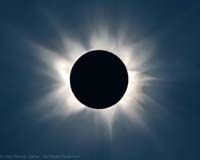 |
New Delhi (AFP) July 21, 2009 India's air force will scramble a fighter jet and a transport plane filled with scientists to photograph and monitor Wednesday's total solar eclipse as it races across the country. The Indian scientists will take off from the Taj Mahal town of Agra on a Russian AN-32 transporter and follow the shadow of the eclipse northwest until the central town of Khajuraho, the air force said. The propeller-driven aircraft will cruise at an altitude of 25,000 feet (7,570 metres), above the monsoon clouds that are threatening to obscure the phenomenon from people on the ground. A French-designed Mirage-2000 fighter jet will also chase the eclipse, taking pictures as it goes. Wednesday's eclipse has stirred up immense excitement due to its trajectory over India and China and the unusually long duration of the instant of greatest eclipse, or "totality" -- when the sun is wholly covered. At its maximum, this will last six minutes and 39 seconds -- a duration that will not be matched until the year 2132. The up to 258-kilometre- (161-mile-) wide shadow cast along the "path of totality" will first make landfall on the western Indian state of Gujarat shortly before 6:30am (0100 GMT).
earlier related report The Shanghai Meteorological Bureau has predicted thunderstorms for when the longest solar eclipse of the 21st century starts at 8:30 am (0030 GMT), according to a forecast released Tuesday evening. "It will be almost impossible to see the eclipse in Shanghai," Li Jinyu, the bureau's chief service operator, was quoted as telling the Shanghai Daily. "Even if there is no rain, the heavy clouds will block the view," he said. However people will still experience the sky changing from bright to dark, the report said. Eastern China has been regarded as one of the best places in the world to view the total eclipse, which is expected to last about six minutes and reach its midpoint around 9:30 am. The event is being described as a once-in-a-lifetime opportunity which, due to its trajectory over China and India, could end up being the most watched eclipse in history. A solar eclipse occurs when the moon is caught between the sun and the earth while each of them moves along their fixed orbits. "This is a very important milestone. None of us will live long enough to see another one like it," said Federico Borgmeyer, the German-based manager of the specialist travel agency Eclipse City, who is in Shanghai for the event. The travel agency said it would proceed with plans to take eclipse chasers to Shanghai's Yangshan island to experience the event despite the forecast. Museums, observatories and specialty stores were sold out of solar eclipse glasses to protect eyes from the intense light, the Shanghai Daily reported. The phenomenon has sparked a mini-tourism boom for Shanghai and other parts of eastern China, such as historic Hangzhou city. Thousands of tourists from around the world have already descended on Shanghai, with hotels and restaurants in marquee locations such as the Bund being quickly booked out. Hyatt on the Bund said its eclipse breakfast event remained fully booked and the weather concerns had not led to any cancellations. "People are just looking for a reason to get together," hotel spokeswoman Meg Zhang said. "You can tell your boss: 'It's only once in 300 years'." The next total solar eclipse will be on July 11, 2010 but far fewer people are likely to see it as it tracks across the South Pacific over French Polynesia and Easter Island to the southern tip of South America. Share This Article With Planet Earth
Related Links Solar and Lunar Eclipses at Skynightly
 Ancient Eclipses In China
Ancient Eclipses In ChinaWashington DC (SPX) Jul 21, 2009 Whenever we think of a country's contribution to astronomy, we first tend to consider its most ancient roots. With Chinese astronomy, those roots go back far longer than any other modern culture. Among the most ancient writings and 'oracle bones' uncovered through painstaking archeology, we see the legacy of the first sightings of eclipses, aurora, sunspots and the solar corona. In their ... read more |
|
| The content herein, unless otherwise known to be public domain, are Copyright 1995-2009 - SpaceDaily. AFP and UPI Wire Stories are copyright Agence France-Presse and United Press International. ESA Portal Reports are copyright European Space Agency. All NASA sourced material is public domain. Additional copyrights may apply in whole or part to other bona fide parties. Advertising does not imply endorsement,agreement or approval of any opinions, statements or information provided by SpaceDaily on any Web page published or hosted by SpaceDaily. Privacy Statement |